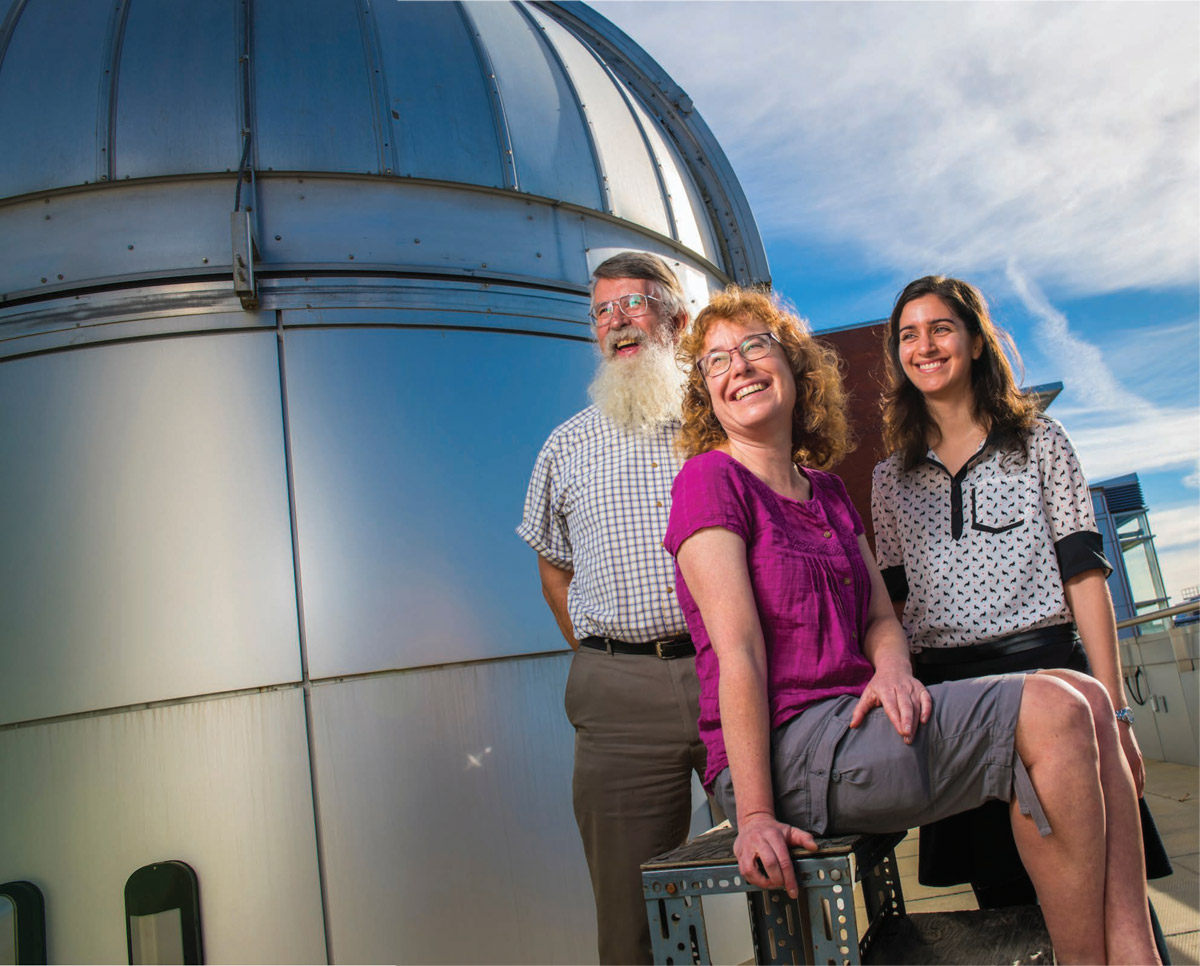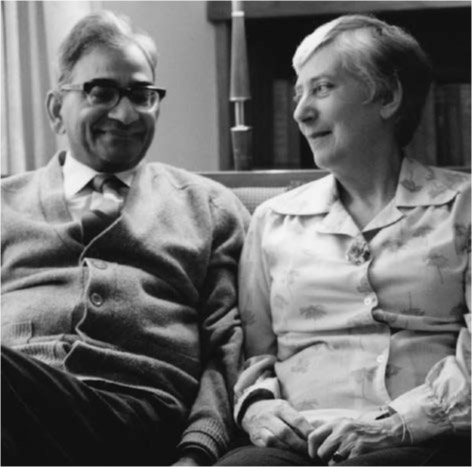
From left, professors Don Page and Sharon Morsink, pictured atop the Department of Physics Observatory with Yasaman Yazdi, the newest Avadh Bhatia post-doctoral fellow.
"I read somewhere that everybody on this planet is separated by only six other people. Six degrees of separation between us and everyone else on the planet."
That quote, from John Guare's play Six Degrees of Separation, vividly describes how networks of people can minimize social and, in some ways, physical distances on this planet.
For example, the University of Alberta's new Avadh Bhatia post-doctoral fellow, Yasaman Yazdi, is six connections away from the man for whom her fellowship is named. Yazdi is a University of Waterloo graduate who came to Alberta to work with physics professor Don Page (that's the first degree of separation), who was once a post-doc for renowned physicist Stephen Hawking (the second degree in this scenario).
When Hawking was at Caltech, he met Page and another physicist, Werner Israel (the third degree), who would become a U of A professor. Hawking and Israel, now professor emeritus, have collaborated many times over their storied careers. Israel's own work inspired Sharon Morsink ('97 PhD) to seek him out as her thesis supervisor at the U of A. Morsink (the fourth degree) was awarded the very first Avadh Bhatia Postdoctoral Fellowship thanks to a unique arrangement made by then associate chair for graduate studies Helmy Sherif (the fifth degree). Years before, in 1969, Sherif had applied for a post-doctoral position at the U of A not knowing that the director of the Theoretical Physics Institute here was Avadh Bhatia (the sixth degree). Even back then, without instant digital communication and ubiquitous air travel, the research world was deeply interconnected.
Influential and inspirational
It is not surprising that Bhatia would figure prominently in so many physics researchers' networks. He was both a brilliant scientist and networker. He joined the university in 1955 and went on to help recruit the likes of Sherif, Israel, and many others. Bhatia had a profound influence in shaping the Department of Physics. His research influenced the fields of condensed matter physics and astrophysics, his teaching and supervision skills inspired students, and his leadership helped to establish the Theoretical Physics Institute.
Bhatia died in 1984 after a long illness. He was so esteemed by his colleagues that several physics professors wrote in support of renaming the physics building after him. "He came to the University of Alberta in 1955 with an already established international reputation," they wrote on Jan. 10, 1985. "His work on electron scattering in metals in collaboration with Krishnan in the 1940s has been described by a distinguished reviewer (J.M. Ziman) as 'the key to the gate.' His contributions to nuclear reaction theory in the early 1950s are cited in anthologies as among the classic papers in the field."
In the following years, his widow, June Bhatia, was interested in helping women in physics. June was known in the literary world as Helen Forrester. Under that name, she had written a bestselling series of memoirs based on her life growing up in wartime England. It was in England after the Second World War that June met Avadh, then a citizen of India, who was a post-doctoral fellow with physics giant Herbert Fröhlich at the University of Liverpool. By establishing the Avadh Bhatia Postdoctoral Fellowship for women, June extended her husband's influence to subsequent generations of physicists.
"My father respected good brains," says Robert Bhatia, whose recent book, Passage Across the Mersey, focuses on his mother June's life, including extensive chapters about her relationship with Avadh. The younger Bhatia says that his father grew up in a traditional family in India but subscribed to a liberal religious sect of Hinduism. "He appreciated the contribution that women could make and saw that inclusivity was vital."
Hélène Narayana, the only woman in the U of A's PhD program in physics in the late 1960s, befriended the Bhatias, who, like her and her husband, were in a marriage that combined European and South Asian families. She remembers Avadh as a kind and generous professor who stepped in as her thesis adviser when her supervisor was on sabbatical. "He didn't treat me as some kind of curiosity, unlike some other people," says Narayana, who went on to become a journalist and peace activist. Narayana believes that Avadh Bhatia would have liked the fellowship named in his honour. "He would have been delighted, because it came from his wife."
Strong ties
About 30 years after Narayana completed her PhD, an engineering student at the University of Waterloo came to the realization that she was more interested in fundamental scientific research than she was in mechanics. "I noticed that I was reading Scientific American while my classmates were reading car magazines," recalls Sharon Morsink ('97 PhD), now an associate professor of physics at the U of A. So, she transferred to science and completed a bachelor of science degree. In 1991, as she was trying to decide where to do her graduate work, the U of A offered her the Avadh Bhatia fellowship. She accepted.
Morsink did not know that the prize was initially intended for post-doctoral fellows. The one-time modification was suggested by Helmy Sherif, the associate chair of graduate studies at the time.
Sherif himself had a strong tie to Avadh Bhatia. As a master's student in Egypt in the 1960s, Sherif's thesis work was closely based on Bhatia's seminal work from the early 1950s at the University of Liverpool on the theory of nuclear reactions. Sherif continued this type of research as a graduate student at the University of Washington. He did not realize until after he accepted an offer from the U of A that he would soon be a colleague of the man who inspired his work in the field of theoretical physics. Years later, Sherif helped to launch Bhatia's namesake award.
"We felt that it would take time to get a female postdoctoral fellow," Sherif recalls. "It was near the start of the year, so I suggested, 'Why not for this year use it for a graduate student?' June Bhatia agreed," recalls Sherif, now professor emeritus.
On the shoulders of giants
Morsink didn't know anyone in Edmonton, but she knew the work of Professor Werner Israel, a world-leading theoretical physicist. (He was also one of the professors who wrote in support of renaming the physics building after Bhatia.) Standing on the shoulders of these giants, Morsink wrote her thesis on the insides of black holes. She went on to post-doctoral work at the University of Wisconsin and was then hired on to the faculty of the Department of Physics at the U of A.
Now, Morsink is set to launch a new massive open online course (MOOC) on cosmology and black holes, bringing Bhatia's influence further out into the public sphere. "I was interested in doing this because, of course, I did my PhD on black holes from very much a mathematical and theoretical point of view," says Morsink, who has since expanded her research interests to include astrophysics and observational astronomy. "The MOOC is going to look at how people observe black holes and the cool, theoretical stuff of black holes, for example, the event horizon, the singularity, and Hawking radiation."
Other U of A experts who will appear in the MOOC include physics professors Doug Gingrich- who is currently looking to observe black holes at the Large Hadron Collider-and Don Page, who, in addition to collaborating with physics giant Stephen Hawking, is a major expert in black holes in his own right. (Morsink notes that like herself, Page was drawn to the U of A by Werner Israel, further signalling how profound the influence of just one person can be.)
Full circle in space and time
Meanwhile, Avadh Bhatia's legacy continues with the most recent recipient of the Avadh Bhatia fellowship, Yasaman Yazdi. Like Sharon Morsink, Yazdi is also a graduate of the University of Waterloo and came to Edmonton where the Department of Physics has expertise in her chosen area of study. "The kind of research I was interested in was more heavily motivated by general relativity, so it was important to me to come to a department with a faculty with a lot of experience in classical general relativity," says Yazdi, who had been based at Waterloo's famed Perimeter Institute. "At the U of A, Don Page was the perfect candidate for that. He's part of the generation of physicists who did work on general relativity during its golden age."
Yazdi will explore new ground as she probes the big questions involving the nature of space and time. "Broadly, my research is in the field of quantum gravity, which is a field in search of a theory that doesn't exist yet." By opening new lines of inquiry, Yazdi will be extending research networks, and hopefully trigger another six degrees of scientific excellence.


